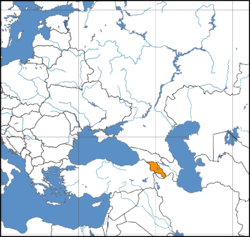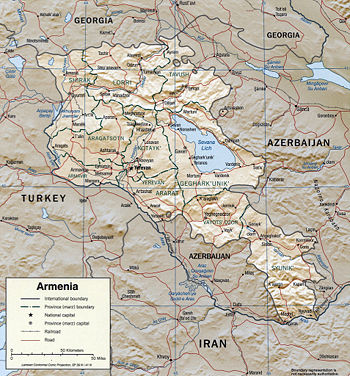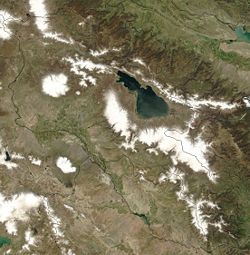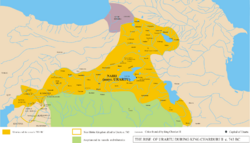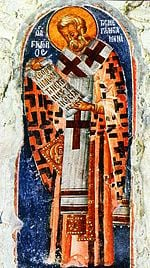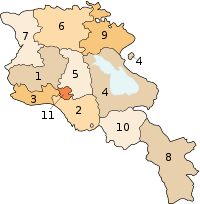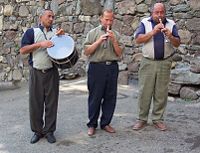Difference between revisions of "Armenia" - New World Encyclopedia
Mike Butler (talk | contribs) m |
Mike Butler (talk | contribs) m |
||
| Line 70: | Line 70: | ||
'''Armenia''' (Armenian: ''Hayastan''), officially the '''Republic of Armenia''', is a landlocked, mountainous country located in the [[Southern Caucasus]] between the [[Black Sea]] and the [[Caspian Sea]]. | '''Armenia''' (Armenian: ''Hayastan''), officially the '''Republic of Armenia''', is a landlocked, mountainous country located in the [[Southern Caucasus]] between the [[Black Sea]] and the [[Caspian Sea]]. | ||
| − | |||
| − | |||
Armenia has been populated since prehistoric times, and has been proposed as the site of the Biblical [[Garden of Eden]]. Armenia lies in the highlands surrounding the Biblical mountains of [[Mount Ararat|Ararat]], upon which, as [[Judeo-Christian]] theology states, [[Noah's Ark]] came to rest after the [[Flood (mythology)|flood]]. (Gen. 8:4). | Armenia has been populated since prehistoric times, and has been proposed as the site of the Biblical [[Garden of Eden]]. Armenia lies in the highlands surrounding the Biblical mountains of [[Mount Ararat|Ararat]], upon which, as [[Judeo-Christian]] theology states, [[Noah's Ark]] came to rest after the [[Flood (mythology)|flood]]. (Gen. 8:4). | ||
| − | + | Armenia prides itself on being the first nation to adopt [[Christianity]] as its official religion. A former republic of the [[Soviet Union]], today Armenia is constitutionally a secular state, but the Christian faith plays a major role. | |
| − | |||
| − | |||
| − | + | During World War I in the western portion of Armenia, Ottoman Turkey instituted a policy of forced resettlement coupled with other harsh practices that resulted in an estimated one million Armenian deaths. | |
==Etymology== | ==Etymology== | ||
Revision as of 23:28, 27 March 2007
| Հայաստանի Հանրապետություն Hayastani Hanrapetutyun Republic of Armenia | |||||
| |||||
| Motto: Armenian: Մեկ Ազգ , Մեկ Մշակույթ Transliteration: Mek Azg, Mek Mshakowyt "One Nation, One Culture" | |||||
| Anthem: Mer Hayrenik ("Our Fatherland") | |||||
| Capital | File:Yerevan coa.gif Yerevan1 40°16′N 44°34′E | ||||
|---|---|---|---|---|---|
| Largest city | capital | ||||
| Official languages | Armenian | ||||
| Government | Unitary republic | ||||
| - President | Robert Kocharian | ||||
| - Prime Minister | Andranik Margaryan | ||||
| Independence | from the USSR | ||||
| - Declared | August 23 1990 | ||||
| - Recognised | September 21 1991 | ||||
| - Finalised | December 25 1991 | ||||
| - Traditional foundation of the Armenian nation |
August 11 2492 B.C.E. | ||||
| - Kingdom of Urartu established | 1000 B.C.E. | ||||
| - Kingdom of Armenia formed | 600 B.C.E. | ||||
| - Christianity officially adopted | 301 C.E. | ||||
| - Democratic Republic of Armenia established |
May 28, 1918 | ||||
| Area | |||||
| - Total | 29,800 km² (141st) 11,506 sq mi | ||||
| - Water (%) | 4.71 | ||||
| Population | |||||
| - 2005 estimate | 3,215,800[1] | ||||
| - 2001 census | 3,002,594 | ||||
| - Density | 101/km² 262/sq mi | ||||
| GDP (PPP) | 2005 estimate | ||||
| - Total | $14.17 billion | ||||
| - Per capita | $4,270 | ||||
| HDI (2004) | |||||
| Currency | Dram (AMD)
| ||||
| Time zone | UTC (UTC+4) | ||||
| - Summer (DST) | DST (UTC+5) | ||||
| Internet TLD | .am | ||||
| Calling code | +374 | ||||
| 1 Alternatively spelled as "Erevan", "Jerevan", or "Erivan". 2 Rank based on 2005 UN estimate of de facto population. | |||||
Armenia (Armenian: Hayastan), officially the Republic of Armenia, is a landlocked, mountainous country located in the Southern Caucasus between the Black Sea and the Caspian Sea.
Armenia has been populated since prehistoric times, and has been proposed as the site of the Biblical Garden of Eden. Armenia lies in the highlands surrounding the Biblical mountains of Ararat, upon which, as Judeo-Christian theology states, Noah's Ark came to rest after the flood. (Gen. 8:4).
Armenia prides itself on being the first nation to adopt Christianity as its official religion. A former republic of the Soviet Union, today Armenia is constitutionally a secular state, but the Christian faith plays a major role.
During World War I in the western portion of Armenia, Ottoman Turkey instituted a policy of forced resettlement coupled with other harsh practices that resulted in an estimated one million Armenian deaths.
Etymology
The original Armenian language name for the country was Hayq. The name later evolved into Hayastan a combination of Hayasa (Հայասա) or Hayk (Հայկ) with the Persian language suffix '-stan' (land) in the Middle Ages. Hayk was one of the great Armenian leaders after whom the The Land of Hayk was named.
Pre-Christian accounts suggest that “Nairi”, meaning "land of rivers", used to be an ancient name for the country's mountainous region, first used by Assyrians around 1200 B.C.E. In the fifth century B.C.E., Herodotus, in his review of the troops opposing the Greeks, he wrote that “the Armenians were armed like the Phrygians, being Phrygian settlers (refugees).
The traditional etymology for the ethnology is from Armenak or Aram, the great-grandson of Haik's great-grandson, and another leader who is, according to Armenian tradition, the ancestor of all Armenians. Akkadian language inscriptions (2400 B.C.E.) mention Armani, locating them in the southern Armenian Highlands near Lake Van. Armani was the earlier form of Armens who were of Proto-Indo-European descent. To this day Assyrians (direct descendents of Akkadians) refer Armenians by their inscription form Armani.
Geography
Located between the Black and Caspian Seas, Armenia is bordered on the north and east by Georgia and Azerbaijan, and on the south and west by Iran and Turkey.
The Republic of Armenia, covering an area of 11,600 square miles (30,000 square kilometres) is located in the north-east of the Armenian Highland. The highland, that covers 154,000 square miles (400;000km²), is otherwise known as historic Armenia and considered as the original homeland of Armenians. Armenia is slightly smaller than the state of Maryland in the United States.
Twenty-five million years ago, a geological upheaval pushed up the earth's crust to form the Armenian Plateau, creating the complex topography of modern Armenia. The Lesser Caucasus range extends through northern Armenia, runs southeast between Lake Sevan and Azerbaijan, then passes roughly along the Armenian-Azerbaijani border to Iran. Thus situated, the mountains make travel from north to south difficult.
The terrain is mostly mountainous, with fast flowing rivers and few forests. The climate is highland continental, which means that the country is subjected to hot summers and cold winters. The land rises to 13,435 feet (4095 meters) above sea-level at Mount Aragats, and no point is below 1312 feet (400 meters) above sea level.
Mount Ararat, which was historically part of Armenia, is the highest mountain in the region. One of the national symbols of Armenia, it was given to Turkey by the Soviet Union according to the Treaty of Kars in 1921.
The climate in Armenia is markedly continental. Summers are dry and sunny, lasting from June to mid-September. The temperature fluctuates between 72° Fahrenheit (22° Celsius) and 96.8° F (36°C). However, the low humidity level mitigates the effect of high temperatures. Evening breezes blowing down the mountains provide a welcome refreshing and cooling effect. Springs are short, while falls are long. Autumns are known for their vibrant and colorful foliage. Winters are quite cold with plenty of snow, with temperatures ranging between 23°F (-5°C) and 14°F (-10°C). Winter sports enthusiasts enjoy skiing down the hills of Tsakhkadzor, located 30 minutes outside Yerevan.
Lake Sevan nestled up in the Armenian highlands, 45 miles (72.5km) across at its widest point and 233 miles (376km) long. is the second largest lake in the world relative to its altitude, 6233 feet (1900 meters) above sea level.
The valleys of the Debet and Akstafa rivers form the chief routes into Armenia from the north as they pass through the mountains. Terrain is most rugged in the extreme southeast, which is drained by the Bargushat River, and most moderate in the Aras River valley to the extreme southwest. Most of Armenia is drained by the Aras, or its tributary the Razdan, which flows from Lake Sevan.
Armenia is located in what geographers call the Aral Caspian Lowland. The country has broad sandy deserts and low grassy plateaus. The region is home to European bison, snow leopards, cheetahs, and porcupines.
Geological turmoil continues in the form of devastating earthquakes, which have plagued Armenia. In December 1988, the second largest city in the republic, Leninakan (now Gyumri), was heavily damaged by a massive quake that killed more than 25,000 people.

Environmental issues include: soil pollution from toxic chemicals such as DDT; deforestation, caused by citizens scavenged for firewood during an energy blockade in the conflict with Azerbaijan; pollution of Hrazdan (Razdan) and Aras Rivers; diminishing drinking water supplies, as a result of draining Lake Sevan for hydropower; and the unsafe restart of the Metsamor nuclear power plant.
Most of the population lives in the western and northwestern parts of the country, where the two major cities, Yerevan and Gyumri (which was called Aleksandropol' during the tsarist period), are located. Yerevan is Armenia's industrial, transportation, and cultural center.
History
Armenia has been populated since prehistoric times, and has been proposed as the site of the Biblical Garden of Eden. Armenia lies in the highlands surrounding the Biblical mountains of Ararat, upon which, as Judeo-Christian theology states, Noah's Ark came to rest after the flood. (Gen. 8:4).
Archaeologists continue to uncover evidence that Armenia and the Armenian Highlands were among the earliest sites of human civilization. However, a tomb has been dated to 9000 B.C.E. From 6000 B.C.E. to 1000 B.C.E., tools such as spears and axes and trinkets of copper, bronze and iron were commonly produced in Armenia and traded in neighbouring lands where those metals were less abundant.
The territory of Armenia is also one of the candidates for the legendary Aratta, mentioned in Sumerian records. In the Bronze Age, several states flourished in the area of Greater Armenia, including the Hittite Empire (at the height of its power), Mitanni (South-Western historic Armenia) and Hayasa-Azzi (fifteenth to twelfth centuries B.C.E.).
The existence of Armenia as a cultural entity begins with the Hayasa-Azzi and the Armens. The legendary founder of Armenia was Hayk, a chieftain who called on his kinsmen to unite into a single nation, thus forming Armenia. According to legend, Hayk was a great-great-grandson of Noah (son of Togarmah, who was a son of Gomer, who was a son of Japheth, who was a son of Noah), and according to an ancient Armenian tradition, a forefather of all Armenian people.
In the Iron Age, the Indo-European Phrygians and Mushkis arrived in the Near East, and toppled the Mitanni Kingdom. Then, the Nairi people (twelfth to ninth centuries B.C.E.) and the Kingdom of Urartu (ninth to sixth centuries B.C.E.) successively established their sovereignty over the Armenian Highland. Yerevan, the modern capital of Armenia, was founded in 782 B.C.E. by the Urartian king Argishti I.
Around 600 B.C.E., the Kingdom of Armenia was established under the Orontid Dynasty, which existed under several local dynasties till 428 C.E. The kingdom reached its height between 95 - 66 B.C.E. under Tigranes the Great, becoming one of the most powerful kingdoms of its time within the region.
In 301, Armenia became the first country in the world to adopt Christianity as its official state religion, while a number of Christian communities have been established in Armenia since 40 C.E. There had been various pagan communities before Christianity, but they were converted by an influx of Christian missionaries. Tiridates III (238-314 C.E.) was the first ruler to officially Christianise his people, his conversion 10 years before the Roman Empire granted Christianity official toleration under Galerius, and 36 years before Constantine the Great was baptised.
After the fall of the Armenian kingdom in 428 C.E., most of Armenia was incorporated as a marzpanate within the Persian Sassanid Empire, ruled by a marzpan. Following an Armenian rebellion in 451 C.E., Christian Armenians maintained their religious freedom, while Armenia gained autonomy and the right to be ruled by an Armenian marzpan, whereas other imperial territories were ruled exclusively by Persians. The Marzpanate of Armenia lasted until the 630s, when Sassanid Persia was destroyed by the Arab Caliphate.
Medieval Armenia
Armenia emerged from the Marzpanate period as an autonomous principality within the Arabic Empire, reuniting Armenian lands previously taken by the Byzantine Empire. The principality was ruled by the Prince of Armenia, recognised by the Caliph and the Byzantine Emperor. It was part of the administrative division Arminiyya created by the Arabs, which also included parts of Georgia and Caucasian Albania, and had its center in the Armenian city Dvin. The Principality of Armenia lasted till 884, when it regained its independence from the weakened Arabic Empire.
The re-emergent Armenian kingdom was ruled by the Bagratuni dynasty, and lasted till 1045. Several areas separated as independent kingdoms and principalities. In 1045, the Byzantine Empire conquered Bagratid Armenia, and soon controlled the other Armenian states.
In 1071 Seljuk Turks defeated the Byzantines and conquered Armenia at the Battle of Manzikert, establishing the Seljuk Empire. To escape death or servitude, Gagik II, King of Ani, an Armenian named Ruben I , with some of his countrymen went into the gorges of the Taurus Mountains and then into Tarsus of Cilicia. The Byzantine governor of the palace gave them shelter where the Armenian Kingdom of Cilicia was eventually established.
The Seljuk Empire soon started to collapse. In the early 1100s, Armenian princes of the Zakarid noble family established a semi-independent Armenian principality in Northern and Eastern Armenia, known as Zakarid Armenia. The Orbelian Dynasty shared control of various parts of the country.
Foreign rule
During the 1230s, the Mongol Ilkhanate conquered the Zakaryan Principality, as well as the rest of Armenia. Other Central Asian tribes invaded, from the 1200s until the 1400s, weakening Armenia. During the 1500s, the Ottoman Empire and Safavid Persia divided Armenia.. The Russian Empire later incorporated Eastern Armenia (consisting of the Erivan and Karabakh khanates within Persia) in 1813 and 1828.
Under Ottoman rule, the Armenians were granted considerable autonomy within their own enclaves and lived in relative harmony with other groups. However, as Christians under a strict Muslim social system, Armenians faced pervasive discrimination. When they began pushing for more rights within the Ottoman Empire, Sultan ‘Abdu’l-Hamid II, organised state-sponsored massacres between 1894 and 1896, resulting in an estimated death toll of 80,000 to 300,000 people. The Hamidian massacres, as they came to be known, gave Hamid international infamy as the "Red Sultan" or "Bloody Sultan."
Mount Ararat was conquered several times and fell into the hands of the Russian Empire in the aftermath of the last Russo-Persian War (1826-1828). After achieving independence from the Russian Empire and the Transcaucasian Democratic Federative Republic, the Democratic Republic of Armenia gained control of the mountain. However, after the republic's conquest by Bolshevik forces, it was ceded to Turkey as part of the Turkish-Soviet friendship agreement, the Treaty of Kars.
World War I and the Armenian Genocide
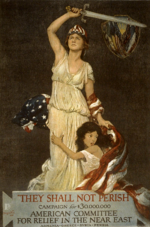
As the Ottoman Empire began to collapse, the Young Turks overthrew the government of Sultan Hamid, bringing hope to Armenians living in the empire. However, during World War I and the Ottoman assault on Russia, the new government began to distrust the Armenians, mainly because the Russian army contained a contingent of Armenian volunteers. On April 24, 1915, Ottoman authorities arrested Armenian intellectuals, and between 1915 and 1917, a large proportion of Armenians living in Anatolia perished in what has become known as the Armenian Genocide. Armenians and Western historians regard this as state-sponsored mass killings, or genocide, although Turkish authorities say the deaths were the result of a civil war coupled with disease and famine. Estimates for the number of Armenians killed range from 650,000 to 1.5 million. These events are commemorated yearly on April 24, the Armenian Martyr Day, or the Day of the Armenian Genocide.
Although the Russian army gained most of Ottoman Armenia during World War I, their gains were lost in 1917, when Eastern Armenia, Georgia, and Azerbaijan united in the Transcaucasian Democratic Federative Republic. All three parties decided to dissolve this federation in May 1918. As a result, Eastern Armenia became independent as the Democratic Republic of Armenia on May 28, 1918, and lasted until December 4, 1920.
At the end of the war, the victorious Entente powers sought to divide up the Ottoman Empire. The Treaty of Sèvres, signed on August 10, 1920, promised to maintain the existence of the democratic republic and to attach the former territories of Ottoman Armenia to it. The treaty was rejected by the Turkish National Movement, and never came into effect. That movement, under Mustafa Kemal Atatürk, used the treaty as the occasion to declare itself the rightful government of Turkey, replacing the monarchy based in Istanbul with a republic based in Ankara.
Soviet Armenia
A violent conflict, known as the Turkish-Armenian War, broke out in late 1920. The Treaty of Alexandropol, signed on December 2, forced Armenia to disarm, to cede more than 50 percent of its pre-war territory, and to give up all the territories granted to it at the Sèvres treaty. Meanwhile, the Soviet Eleventh Army had invaded Armenia at Karavansarai (present-day Ijevan) on November 29. By December 4, Soviet forces entered Yerevan and the short-lived Armenian republic collapsed. Armenia was annexed by Bolshevist Russia and in 1922 was incorporated into the Soviet Union as part of the Transcaucasian SFSR along with Georgia and Azerbaijan. The Treaty of Alexandropol was then superseded by the Treaty of Kars, between Turkey and the Soviet Union. In it, Turkey allowed the Soviet Union to assume control over Ajara with the port city of Batumi in return for sovereignty over the cities of Kars, Ardahan, and Iğdır, all of which were part of Russian Armenia.
The TSFR existed from 1922 to 1936, when it was divided up into three separate entities (Armenian SSR, Azerbaijan SSR, and Georgian SSR). Armenians enjoyed a period of relative stability under Soviet rule. They received medicine, food, and other provisions from Moscow, and communist rule proved to be a soothing balm in contrast to the turbulent final years of the Ottoman Empire. The situation was difficult for the church, which struggled under Soviet rule. After the death of Vladimir Lenin, Joseph Stalin took power. As with various other ethnic minorities who lived in the Soviet Union during Stalin's Great Purge, tens of thousands of Armenians were either executed or deported.
Stalin died in 1953. Under the new Soviet leader Nikita Khruschev, life in Soviet Armenia improved. The church was revived when Catholicos Vazgen I assumed the duties of his office in 1955. In 1967, a memorial to the victims of the Armenian Genocide was built at the Tsitsernakaberd hill above the Hrazdan gorge in Yerevan after mass demonstrations took place the tragic event's 50th anniversary in 1965.
During Mikhail Gorbachev’s leadership in the 1980s with the reforms of Glasnost and Perestroika, Armenians began to demand better environmental care for their country, opposing the pollution that Soviet-built factories brought. Tensions developed between the Armenian and Azerbaijani republics over the region of Nagorno-Karabakh. At the same time, Soviet Armenia suffered the devastating 1988 Spitak earthquake. Gorbachev's inability to solve Armenia's problems (especially Karabakh) led many Armenians to become disillusioned with the Soviet leader. Instead, it created a growing hunger for independence.
Independence
In 1991, the Soviet Union broke apart and Armenia re-established its independence. The initial post-Soviet years were marred by the continued confrontation with Azerbaijan over Nagorno-Karabakh. A Russian-brokered cease-fire was put in place in 1994. Since then, Armenia and her neighbor have held peace talks, mediated by the Organization for Security and Co-operation in Europe (OSCE). The status over Karabakh has yet to be determined and the economies of both countries have been hurt in the absence of a complete resolution.
Politics
Politics of Armenia takes place in a framework of a presidential representative democratic republic. According to the Constitution of Armenia, the President is the head of government and of a pluriform multi-party system. Executive power is exercised by the government. Legislative power is vested in both the government and parliament. The unicameral parliament (also called the Azgayin Zhoghov or National Assembly) is controlled by a coalition of three political parties: the conservative Republican party, the Armenian Revolutionary Federation, and the Country of Law party. The main opposition is composed of several smaller parties joined in the Justice Bloc. Robert Kocharian is the republic's current president.
The Armenian government's stated aim is to build a Western-style parliamentary democracy as the basis of its form of government. However, international observers of Council of Europe and U.S. Department of State have questioned the fairness of Armenia's parliamentary and presidential elections and constitutional referendum since 1995, citing polling deficiencies, lack of cooperation by the Electoral Commission, and poor maintenance of electoral lists and polling places. Freedom House ranked Armenia as "partly free" in its 2007 report, though it did not categorize Armenia as an "electoral democracy", indicating an absence of relatively free and competitive elections.[2] It has universal suffrage above the age of eighteen.
Military
The Armenian Army, Air Force, Air Defense, and Border Guard comprise the four branches of the Armed Forces of the Republic of Armenia. The Armenian military was formed after the collapse of the Soviet Union in 1991 and with the establishment of the Ministry of Defense in 1992. The Commander-in-Chief of the military is the President of Armenia, Robert Kocharian. The Ministry of Defense is in charge of political leadership, currently headed by Serzh Sargsyan, while military command remains in the hands of the General Staff, headed by the Chief of Staff, who is currently Colonel-General Mikael Harutiunian.[citation needed]
Active forces now number about 60,000 soldiers, with an additional reserve of 32,000, and a "reserve of the reserve" of 350,000 troops. Armenian border guards are in charge of patrolling the country's borders with Georgia and Azerbaijan, while Russian troops continue to monitor its borders with Iran and Turkey. In the case of an eventual attack, Armenia is prepared to mobilise every able-bodied man between the age of 15 and 59, with military preparedness.[citation needed]
The Treaty on Conventional Armed Forces in Europe, which establishes comprehensive limits on key categories of military equipment, was ratified by the Armenian parliament in July 1992. In March 1993, Armenia signed the multilateral Chemical Weapons Convention, which calls for the eventual elimination of chemical weapons. Armenia acceded to the Nuclear Non-Proliferation Treaty (NPT) as a non-nuclear weapons state in July 1993. Armenia is member of Collective Security Treaty Organization (CSTO) along with Belarus, Kazakhstan, Kyrgyzstan, Russia, Tajikistan and Uzbekistan. It participates in NATO's Partnership for Peace (PiP) program and is in a NATO organization called Euro-Atlantic Partnership Council (EAPC). Armenia has engaged in peacekeeping mission in Kosovo as part of non-NATO KFOR troops under Greek command.[3] Its 46 troops are also part of Coalition Forces in Iraq War.[4]
Administrative divisions
Armenia is divided into ten marzes (regions, singular marz), with the city of Yerevan (Template:Hayeren) having special administrative status as the country's capital. The chief executive in each of then ten marzes is the marzpet (marz governor), appointed by the government of Armenia. In Yerevan, the chief executive is the mayor, appointed by the president.
- Aragatsotn (Template:Hayeren)
- Ararat (Template:Hayeren)
- Armavir (Template:Hayeren)
- Gegharkunik (Template:Hayeren)
- Kotayk (Template:Hayeren)
- Lori (Template:Hayeren)
- Shirak (Template:Hayeren)
- Syunik (Template:Hayeren)
- Tavush (Template:Hayeren)
- Vayots Dzor (Template:Hayeren)
- Yerevan (Template:Hayeren; special administrative status)
Economy
Before independence, Armenia's economy was largely industry-based – chemicals, electronics, machinery, processed food, synthetic rubber, and textiles – and highly dependent on outside resources. Agriculture contributed only 20 percent of net material product and 10 percent of employment before the break-up of the Soviet Union in 1991. The republic had developed a modern industrial sector, supplying machine tools, textiles, and other manufactured goods to sister republics in exchange for raw materials and energy.
Armenian mines produce copper, zinc, gold, and lead. The vast majority of energy is produced with fuel imported from Russia, including gas and nuclear fuel (for its one nuclear power plant); the main domestic energy source is hydroelectric. Small amounts of coal, gas, and petroleum have not yet been developed.
Like other newly independent states of the former Soviet Union, Armenia's economy suffers from the legacy of a centrally planned economy and the breakdown of former Soviet trading patterns. Soviet investment in and support of Armenian industry has virtually disappeared, so that few major enterprises are still able to function.
In addition, the effects of the 1988 Spitak Earthquake, which killed more than 25,000 people and made 500,000 homeless, are still being felt. The conflict with Azerbaijan over Nagorno-Karabakh has not been resolved. The closure of Azerbaijani and Turkish borders has devastated the economy, because Armenia depends on outside supplies of energy and most raw materials. Land routes through Georgia and Iran are inadequate or unreliable.
Gross domestic product fell nearly 60 percent from 1989 until 1992–1993. The national currency, the dram, suffered hyperinflation for the first years after its introduction in 1993.
Nevertheless, the government was able to make wide-ranging economic reforms that paid off in dramatically lower inflation and steady growth. The 1994 cease-fire in the Nagorno-Karabakh conflict has helped the economy. Armenia has had strong economic growth since 1995, building on the turnaround that began the previous year, and inflation has been negligible for the past several years. New sectors, such as precious stone processing and jewelry making, information and communication technology, and even tourism are beginning to supplement more traditional sectors in the economy, such as agriculture.
Loans to Armenia since 1993 exceed $1.1 billion. These loans are targeted at reducing the budget deficit, stabilizing the currency; developing private businesses; energy; the agriculture, food processing, transportation, and health and education sectors; and ongoing rehabilitation in the earthquake zone. The government joined the World Trade Organization on February 5, 2003. One of the main sources of foreign direct investments remains the Armenian diaspora, which finances major parts of the reconstruction of infrastructure and other public projects.
A liberal foreign investment law was approved in June 1994, and a Law on Privatization was adopted in 1997, as well as a program on state property privatization. Unemployment remained at around 30 percent. In 2007 due to the influx of thousands of refugees from the Karabakh conflict.
According to the 2006 Transparency International Corruption Perceptions Index (CPI), Armenia ranked 93rd of 163 countries, a slight increase since it was first ranked in 2003, at 80th. In the 2007 Index of Economic Freedom, Armenia ranked 32nd, ahead of countries like Portugal and Italy.
Exports totalled $1.056-billion in 2006. Export commodities were diamonds, mineral products, foodstuffs, and energy. Export partners were Germany 15.6 percent, Netherlands 13.7 percent, Belgium 12.8 percent, Russia 12.2 percent, Israel 11.5 percent, the United States 11.2 percent, Georgia 4.8 percent, and others 18.2 percent.
Imports totalled $1.684-billion in 2006. Import commodities were natural gas, petroleum, tobacco products, foodstuffs, and diamonds. Import partners were Russia 13.5 percent, Belgium 8 percent, Germany 7.9 percent, Ukraine 7 percent, Turkmenistan 6.3 percent, US 6.2 percent, Israel 5.8 percent, Iran 5 percent, Romania 4.2 percent, others 36.1 percent.
Per capita GDP was $4270 in 2005, or ranked 115 on a list of 181 countries.
Demographics
Armenia has a population of 3,215,800 (April 2006 est.) and is the second most densely populated of the former Soviet republics. There has been a problem of population decline due to elevated levels of emigration after the break-up of the USSR. The rates of emigration and population decline, however, have decreased drastically in the recent years, and a moderate influx of Armenians returning to Armenia have been the main reasons for the trend, which is expected to continue. In fact Armenia is expected to resume its positive population growth by 2010.
Ethnic Armenians make up 97.9% of the population. Yazidis make up 1.3%, and Russians 0.5%. Other minorities include Assyrians, Ukrainians, Greeks, and Kurds as well as smaller communities of Poles, Caucasus Germans, Udis and Tats. Most Azerbaijanis who lived in Armenia left the country for Azerbaijan at the beginning of the Nagorno-Karabakh conflict. During the same period, a large number of Armenians fled from Azerbaijan to Armenia.
Armenia has a relatively large diaspora (8 million by some estimates, greatly exceeding the 3 million population of Armenia itself), with communities existing across the globe. The largest Armenian communities outside of Armenia can be found in Russia, France, Iran, the United States, Georgia, Syria, Lebanon, Argentina, and Ukraine. 40,000 to 70,000 still live in Turkey (mostly in and around Istanbul).[5] Approximately 130,000 Armenians now live in the disputed Nagorno-Karabakh region.[6]
The predominant religion in Armenia is Christianity. The roots of the Armenian Church go back to the first century. According to tradition, the Armenian Church was founded by two of Jesus' twelve apostles — Thaddaeus and Bartholomew — who preached Christianity in Armenia between 40-60 C.E. Because of these two founding apostles, the official name of the Armenian Church is Armenian Apostolic Church. Armenia was the first nation to adopt Christianity as a state religion, in 301. Over 93% of Armenian Christians belong to the Armenian Apostolic Church, a form of Oriental (Non-Chalcedonian) Orthodoxy, which is a very ritualistic, conservative church, roughly comparable to the Coptic and Syriac churches. Armenia also has a population of Catholics (both Roman and Mekhitarist - Armenian Uniate (180,000)), evangelical Protestants and followers of the Armenian traditional religion. The Yazidi Kurds, who live in the western part of the country, practice Yazidism. The Armenian Catholic Church is headquartered in Bzoummar, Lebanon. The non-Yazidi Kurds practice Sunni Islam. The Jewish community in Armenia has diminished from 5,000 to 750 persons since independence due to Armenia's economic difficulties, with most emigrants leaving for Israel. There are currently two synagogues operating in Armenia - in the capital, Yerevan, and in the city of Sevan located near Lake Sevan. Intermarriage with Christian Armenians is frequent. Still, despite these difficulties, a lot of enthusiasm exists to help the community meet its needs. [7]
Culture
Armenians have their own distinctive alphabet and language. The alphabet was invented in 405 AD by Saint Mesrob Mashtots and consists of thirty-eight letters, two of which were added during the Cilician period. 96% of the people in the country speak Armenian, while 75.8% of the population additionally speaks Russian although English is becoming increasingly popular.
Music and the arts
The National Art Gallery in Yerevan has more than 16,000 works that date back to the Middle Ages. The Modern Art Museum, the Children’s Picture Gallery, and the Martiros Saryan Museum are only a few of the other noteworthy collections. Moreover, many private galleries are in operation, with many more opening each year. They feature rotating exhibitions and sales.
The Armenian Philharmonic Orchestra performs at the refurbished city Opera House. In addition, several chamber ensembles are highly regarded for their musicianship, including the National Chamber Orchestra of Armenia and the Serenade Orchestra. Classical music can also be heard at one of several smaller venues, including the Yerevan Komitas State Conservatory and the Chamber Orchestra Hall. Jazz is popular, especially in the summer when live performances are a regular occurrence at one of the city’s many outdoor cafés.
Yerevan’s Vernisage (arts and crafts market), close to Republic Square, bustles with hundreds of vendors selling a variety of crafts on weekends and Wednesdays (though the selection is much reduced mid-week). The market offers woodcarving, antiques, fine lace, and the hand-knotted wool carpets and kilims that are a Caucasus specialty. Obsidian, which is found locally, is crafted into assortment of jewelry and ornamental objects. Armenian gold smithery enjoys a long tradition, populating one corner of the market with a selection of gold items. Soviet relics and souvenirs of recent Russian manufacture—nesting dolls, watches, enamel boxes and so on, are also available at the Vernisage.
Across from the Opera House, a popular art market fills another city park on the weekends. Armenia’s long history as a crossroads of the ancient world has resulted in a landscape with innumerable fascinating archaeological sites to explore. Medieval, Iron Age, Bronze Age and even Stone Age sites are all within a few hours drive from the city. All but the most spectacular remain virtually undiscovered, allowing visitors to view churches and fortresses in their original settings.
The American University of Armenia has graduate programs in Business and Law, among others. The institution owes its existence to the combined efforts of the Government of Armenia, the Armenian General Benevolent Union, U.S. Agency for International Development, and the University of California. The extension programs and the library at AUA form a new focal point for English-language intellectual life in the city.
The members of the nu-metal band System of a Down are all of Armenian descent, although only bassist Shavo Odadjian is from the country.
Hospitality and wedding ceremonies
Armenian hospitality is legendary and stems from ancient tradition. Social gatherings focused around sumptuous presentations of course after course of elaborately prepared and well-seasoned food. The hosts will often put morsels on a guest's plate whenever it is empty or fill his or her glass when it gets low. After a helping or two it is acceptable to refuse politely or, more simply, just leave a little uneaten food. Alcohol such as cognac, vodka, and red wine are usually served during meals and gatherings. It is considered rare and unusual for one to go inside an Armenian household and not be offered coffee, pastry, food, or even water.
The elaborate Armenian wedding process begins when the man and woman are "promised". The man's immediate family (parents, grandparents, and often uncles and aunts) go over to the woman's house to ask for permission from the woman's father for the relationship to continue and hopefully prosper. Once permission is granted by the father, the man gives the woman a "promise ring" to make it official. To celebrate the mutual family agreement, the woman's family opens a bottle of Armenian cognac. After being promised, most families elect to have a semi-large engagement party as well. The girl's family is the one who plans, organises and pays for the party. There is very little involvement by the man's family. At the party, a priest is summoned to pray for the soon-to-be husband and wife and give his blessings. Once the words of prayer have concluded, the couple slide wedding bands on each other's right hands (the ring is moved to the left hand once a formal marriage ceremony is conducted by the Armenian church). The customary time to wait for the marriage is about one year. Unlike in other cultures, the man and his family pay for the wedding. The planning and organization process is usually done by the bride and groom to be.
See also
| Armenia Portal |
|
|
|
ReferencesISBN links support NWE through referral fees
- ↑ De jure population estimate by the National Statistics Service
- ↑ Freedom in the World 2007. Freedom House. Retrieved 2007-02-20.
- ↑ KFOR Contingent: Armenia. Official Web Site of the Kosovo Force (24 January 2006). Retrieved 2007-03-11.
- ↑ "Armenian defense minister to visit Iraq as Armenia to extend small troop presence", The Associated Press, 13 November 2006. Retrieved 2007-02-20.
- ↑ Turay, Anna. Tarihte Ermeniler. Bolsohays:Istanbul Armenians. Retrieved 2007-01-04.
- ↑ Nationmaster.com: Azerbaijan
- ↑ Advocates on Behalf of Jews in Russia, Ukraine, the Baltic States, and Eurasia: Armenia and Jews
External links
- Government
(In alphabetical order of the domain name.)
- Ministry of Foreign Affairs of Armenia
- Public Television of Armenia
- National Statistical Service of Armenia
- Ministry of Health of Armenia
- Central Bank of Armenia
- Constitutional Court of Armenia
- Government of Armenia
- Ministry of Nature Protection of Armenia
- National Assembly of Armenia
- Administration of the President of Armenia
- Other
(In alphabetical order.)
- Armenia-Diaspora official WEB site
- Armenian Embassies, Consulates And Representations
- Armeniapedia.org - Armenian wiki (primarily English)
- Armeniainfo.am Information for tourists
- CIA World Factbook entry on Armenia
- Constitution of the Republic of Armenia.
- Electronic Visa (eVisa) for tourists
- Data
- HyeTad - The Online Armenian Cause In English and Spanish
| Within Armenia |
|
Template:Armenia Template:Cities and towns in Armenia Template:World Heritage Sites in Armenia |
| International membership | ||||||
|
Template:Armenia ties Template:Black Sea Economic Cooperation countries Template:Commonwealth of Independent States
| ||||||
Credits
New World Encyclopedia writers and editors rewrote and completed the Wikipedia article in accordance with New World Encyclopedia standards. This article abides by terms of the Creative Commons CC-by-sa 3.0 License (CC-by-sa), which may be used and disseminated with proper attribution. Credit is due under the terms of this license that can reference both the New World Encyclopedia contributors and the selfless volunteer contributors of the Wikimedia Foundation. To cite this article click here for a list of acceptable citing formats.The history of earlier contributions by wikipedians is accessible to researchers here:
The history of this article since it was imported to New World Encyclopedia:
Note: Some restrictions may apply to use of individual images which are separately licensed.

